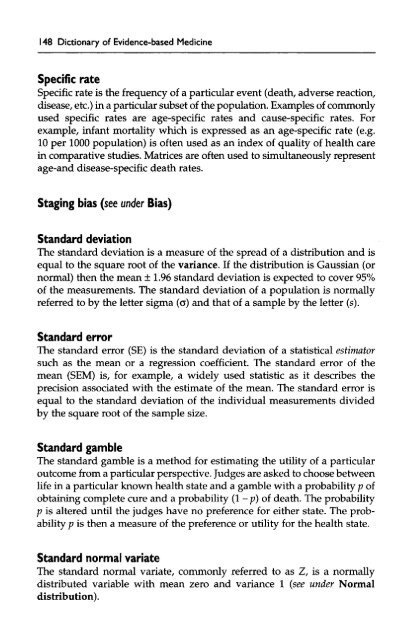Dictionary of Evidence-based Medicine.pdf
Dictionary of Evidence-based Medicine.pdf
Dictionary of Evidence-based Medicine.pdf
Create successful ePaper yourself
Turn your PDF publications into a flip-book with our unique Google optimized e-Paper software.
148 <strong>Dictionary</strong> <strong>of</strong> <strong>Evidence</strong>-<strong>based</strong> <strong>Medicine</strong><br />
Specific rate<br />
Specific rate is the frequency <strong>of</strong> a particular event (death, adverse reaction,<br />
disease, etc.) in a particular subset <strong>of</strong> the population. Examples <strong>of</strong> commonly<br />
used specific rates are age-specific rates and cause-specific rates. For<br />
example, infant mortality which is expressed as an age-specific rate (e.g.<br />
10 per 1000 population) is <strong>of</strong>ten used as an index <strong>of</strong> quality <strong>of</strong> health care<br />
in comparative studies. Matrices are <strong>of</strong>ten used to simultaneously represent<br />
age-and disease-specific death rates.<br />
Staging bias (see under Bias)<br />
Standard deviation<br />
The standard deviation is a measure <strong>of</strong> the spread <strong>of</strong> a distribution and is<br />
equal to the square root <strong>of</strong> the variance. If the distribution is Gaussian (or<br />
normal) then the mean ± 1.96 standard deviation is expected to cover 95%<br />
<strong>of</strong> the measurements. The standard deviation <strong>of</strong> a population is normally<br />
referred to by the letter sigma (o) and that <strong>of</strong> a sample by the letter (s).<br />
Standard error<br />
The standard error (SE) is the standard deviation <strong>of</strong> a statistical estimator<br />
such as the mean or a regression coefficient. The standard error <strong>of</strong> the<br />
mean (SEM) is, for example, a widely used statistic as it describes the<br />
precision associated with the estimate <strong>of</strong> the mean. The standard error is<br />
equal to the standard deviation <strong>of</strong> the individual measurements divided<br />
by the square root <strong>of</strong> the sample size.<br />
Standard gamble<br />
The standard gamble is a method for estimating the utility <strong>of</strong> a particular<br />
outcome from a particular perspective. Judges are asked to choose between<br />
life in a particular known health state and a gamble with a probability p <strong>of</strong><br />
obtaining complete cure and a probability (1 - p) <strong>of</strong> death. The probability<br />
p is altered until the judges have no preference for either state. The probability<br />
p is then a measure <strong>of</strong> the preference or utility for the health state.<br />
Standard normal variate<br />
The standard normal variate, commonly referred to as Z, is a normally<br />
distributed variable with mean zero and variance 1 (see under Normal<br />
distribution).










